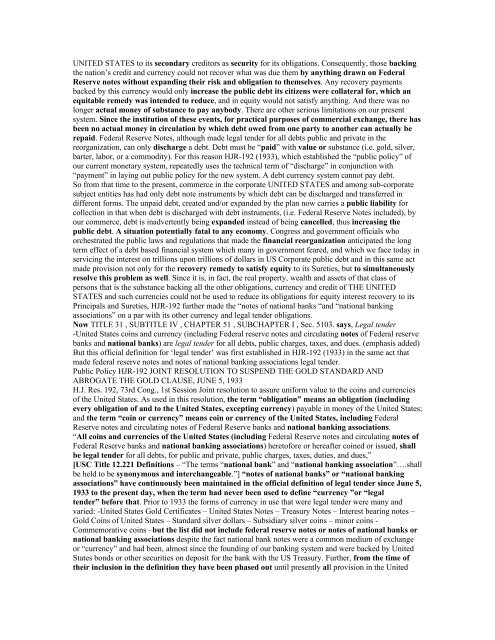Mortgage-KillerEX
Mortgage-KillerEX
Mortgage-KillerEX
Create successful ePaper yourself
Turn your PDF publications into a flip-book with our unique Google optimized e-Paper software.
UNITED STATES to its secondary creditors as security for its obligations. Consequently, those backing<br />
the nation’s credit and currency could not recover what was due them by anything drawn on Federal<br />
Reserve notes without expanding their risk and obligation to themselves. Any recovery payments<br />
backed by this currency would only increase the public debt its citizens were collateral for, which an<br />
equitable remedy was intended to reduce, and in equity would not satisfy anything. And there was no<br />
longer actual money of substance to pay anybody. There are other serious limitations on our present<br />
system. Since the institution of these events, for practical purposes of commercial exchange, there has<br />
been no actual money in circulation by which debt owed from one party to another can actually be<br />
repaid. Federal Reserve Notes, although made legal tender for all debts public and private in the<br />
reorganization, can only discharge a debt. Debt must be “paid” with value or substance (i.e. gold, silver,<br />
barter, labor, or a commodity). For this reason HJR-192 (1933), which established the “public policy” of<br />
our current monetary system, repeatedly uses the technical term of “discharge” in conjunction with<br />
“payment” in laying out public policy for the new system. A debt currency system cannot pay debt.<br />
So from that time to the present, commerce in the corporate UNITED STATES and among sub-corporate<br />
subject entities has had only debt note instruments by which debt can be discharged and transferred in<br />
different forms. The unpaid debt, created and/or expanded by the plan now carries a public liability for<br />
collection in that when debt is discharged with debt instruments, (i.e. Federal Reserve Notes included), by<br />
our commerce, debt is inadvertently being expanded instead of being cancelled, thus increasing the<br />
public debt. A situation potentially fatal to any economy. Congress and government officials who<br />
orchestrated the public laws and regulations that made the financial reorganization anticipated the long<br />
term effect of a debt based financial system which many in government feared, and which we face today in<br />
servicing the interest on trillions upon trillions of dollars in US Corporate public debt and in this same act<br />
made provision not only for the recovery remedy to satisfy equity to its Sureties, but to simultaneously<br />
resolve this problem as well. Since it is, in fact, the real property, wealth and assets of that class of<br />
persons that is the substance backing all the other obligations, currency and credit of THE UNITED<br />
STATES and such currencies could not be used to reduce its obligations for equity interest recovery to its<br />
Principals and Sureties, HJR-192 further made the “notes of national banks “and “national banking<br />
associations” on a par with its other currency and legal tender obligations.<br />
Now TITLE 31 , SUBTITLE IV , CHAPTER 51 , SUBCHAPTER I , Sec. 5103. says, Legal tender<br />
-United States coins and currency (including Federal reserve notes and circulating notes of Federal reserve<br />
banks and national banks) are legal tender for all debts, public charges, taxes, and dues. (emphasis added)<br />
But this official definition for ‘legal tender’ was first established in HJR-192 (1933) in the same act that<br />
made federal reserve notes and notes of national banking associations legal tender.<br />
Public Policy HJR-192 JOINT RESOLUTION TO SUSPEND THE GOLD STANDARD AND<br />
ABROGATE THE GOLD CLAUSE, JUNE 5, 1933<br />
H.J. Res. 192, 73rd Cong., 1st Session Joint resolution to assure uniform value to the coins and currencies<br />
of the United States. As used in this resolution, the term “obligation” means an obligation (including<br />
every obligation of and to the United States, excepting currency) payable in money of the United States;<br />
and the term “coin or currency” means coin or currency of the United States, including Federal<br />
Reserve notes and circulating notes of Federal Reserve banks and national banking associations.<br />
“All coins and currencies of the United States (including Federal Reserve notes and circulating notes of<br />
Federal Reserve banks and national banking associations) heretofore or hereafter coined or issued, shall<br />
be legal tender for all debts, for public and private, public charges, taxes, duties, and dues,”<br />
[USC Title 12.221 Definitions – “The terms “national bank” and “national banking association”….shall<br />
be held to be synonymous and interchangeable.”] “notes of national banks” or “national banking<br />
associations” have continuously been maintained in the official definition of legal tender since June 5,<br />
1933 to the present day, when the term had never been used to define “currency ”or “legal<br />
tender” before that. Prior to 1933 the forms of currency in use that were legal tender were many and<br />
varied: -United States Gold Certificates – United States Notes – Treasury Notes – Interest bearing notes –<br />
Gold Coins of United States – Standard silver dollars – Subsidiary silver coins – minor coins -<br />
Commemorative coins –but the list did not include federal reserve notes or notes of national banks or<br />
national banking associations despite the fact national bank notes were a common medium of exchange<br />
or “currency” and had been, almost since the founding of our banking system and were backed by United<br />
States bonds or other securities on deposit for the bank with the US Treasury. Further, from the time of<br />
their inclusion in the definition they have been phased out until presently all provision in the United












![[Pham_Sherisse]_Frommer's_Southeast_Asia(Book4You)](https://img.yumpu.com/38206466/1/166x260/pham-sherisse-frommers-southeast-asiabook4you.jpg?quality=85)




